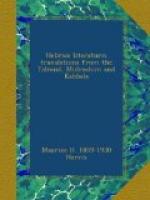Soteh, fol. 13, col. 1.
This story slightly varied,
is repeated in the Book of Jasher
and in the Targum of Ben Uzziel.
The principal works of the hand are forty save one:—To sow, to plow, to reap, to bind in sheaves, to thrash, to winnow, to sift corn, to grind, to bolt meal, to knead, to bake, to shear, to wash wool, to comb wool, to dye it, to spin, to warp, to shoot two threads, to weave two threads, to cut and tie two threads, to tie, to untie, to sew two stitches, to tear two threads with intent to sew, to hunt game, to slay, to skin, to salt a hide, to singe, to tan, to cut up a skin, to write two letters, to scratch out two letters with intent to write, to build, to pull down, to put out a fire, to light a fire, to smite with a hammer, to convey from one Reshuth [a private property in opposition to a public] to another.
Shabbath, fol. 73, col. 1.
King Yanai had a single tree on the royal mound, whence once a month they collected forty seahs (about fifteen bushels) of young pigeons of three different breeds.
Berachoth, fol. 44, col. 1.
Forty years before the destruction of the Temple the Sanhedrin were exiled, and they sat in the Halls of Commerce.
Shabbath, fol. 15, col. 1.
Until one is forty eating is more advantageous than drinking. After that age the rule is reversed.
Ibid., fol. 152, col. 1.
The Rabbis have taught that during the forty years in which Simeon the Just officiated in the Temple the lot always fell on the right (see Lev. xvi. 8-10). After that time it sometimes fell on the right and sometimes on the left. The crimson band also, which in his time had always turned white, after that period sometimes turned white, and at others it did not change color at all.
Yoma, fol. 39, col. 1.
The Rabbis have taught:—Forty years before the destruction of the Temple the lot did not fall on the right, and the crimson band did not turn white; the light in the west did not burn, and the gates of the Temple opened of themselves, so that Rabbi Yochanan ben Zacchai rebuked them, and said, “O Temple! Temple! why art thou dismayed? I know thy end will be that thou shalt be destroyed, for Zachariah the son of Iddo has already predicted respecting thee (Zech. xi. i), ’Open thy doors, O Lebanon, that the fire may devour thy cedars.’”




